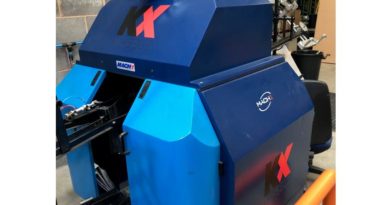Why has use of graphene in cycling goods stalled?
Having burst onto the scene in 2004, Graphene has been a material of intrigue for the bike world ever since, featuring only sporadically in product catalogues despite its wonder properties. Will the material ever be widespread in cycling?
First of all, what is graphene?
Graphene is the thinnest material ever isolated. It consists of single layers of carbon atoms arranged in a hexagonal network, and this unique structure, along with a variety of inherent properties gives it a plethora of potential uses:
Strength: 200 times stronger than steel at the same thickness.
Flexibility: Can stretch up to an additional 20% of its length.
Barrier: Completely impermeable, even to helium gas.
Electrical Conductivity: Over 1 million times more conductive than copper.
Thermal conductivity: Up to 5,000W/mK (watts per metre-kelvin) in all directions, compared to around 400W/mK for copper. Also, it’s non-toxic and fire retardant.
Transparency: Due to its single layer properties, graphene only absorbs about 2.3% of visible light.
Cost: That’s ever-changing and variable but Graphene.info has the price between $50 to $200, per kilogram, depending on the volume bought.
Where in the bicycle industry has it been used?
The list of businesses that have dabbled with graphene technology remains limit- ed. Most notable is the Vittoria group’s work to create a rubber compound that embeds graphene, which it is said hands the tyre have an ultra-low rolling resistance, strength where needed in applications such as downhill and other perks that come naturally.
Having established a joint venture with Directa Plus Asia Ltd to supply the material, Vittoria fine-tuned its use in tyres, while its partner went on to explore other avenues outside of its exclusivity agreement with the global tyre label. One of those possibilities was to tap into the electrical conductivity of the wonder material and Directa Plus went on to explore smart fabrics – that’s clothing that would not only be able to deliver tougher and abrasion resistant weaves, but also potentially become a ‘smart fabric’; one that could in theory tell when a rider is depleted of electrolytes through their sweat, perhaps telling an on board cycle computer in the rider’s eyeline.
Thanks to the immensely broad property list of Graphene, hypothetical scenarios are really quite endless when it comes to innovation. Sourcing the material, taking it through testing, quality control and into production is another story, however.
Rolo Bikes’ Adam Wais told CyclingIndustry.News about his brand’s graphene journey, revealing a complex process that’s not going to appeal to everyone.
He said: “In real terms there’s a very tiny quantity of graphene in existence, but it is of course an atomic-sized particle. Production is extremely complicated and there are many reasons why it’s not used more widely, yet. I know from our experience it’s hard to work with, the raw material is tough to cut and you have to cut it with special equipment.”
Wais points out that with most of the bicycle world’s manufacturing done in Asia, where many fabricators could arguably be said to be cost focused, the material’s use does not stack up in terms of investment at an OEM level. Rolo Bikes partnered with a Swedish specialist for its low-volume graphene infused frame production. It is, admits Wais, a preserve of a certain elite segment of the market when it comes to frames.
“When former pros have ridden our bikes their sense is that it’s just as stiff as a high-spec carbon build, but somehow when they put the power down it reacts even better. It seems to feel much more comfortable too, which is an endurance benefit. The material is incredible for taking out high frequency vibration. With all this said, it remains in the elite ballpark and not mass produced yet; and perhaps not for some time.”
It is a case of the graphene industry maturing and manufacturing at scale, rather than the bicycle industry not having ambition with the material, we’re told.
When asked about his dream hypothetical use for the product, Wais said he would like to use microscopic strands to communicate on systems like Shimano’s Di2, essentially embedding an invisible Graphene cable into the carbon weave.
On volume of production, First Graphene Limited is one early innovator in the segment that pioneered a proprietary process that utilises high purity graphite, something that enabled precise control over production quality. The company markets a range of products for various applications under the PureGRAPH® brand and is now capable of producing 100 tonnes of its graphene products a year from a manufacturing facility in Western Australia, with capability to scale up.
Whether or not volume is available to satisfy demand at the present time seems irrelevant. Revisiting companies who have dabbled in Graphene it is interesting to learn that both Muc-Off and Exposure Lights have ceased producing items that were brought to market building in the wonder material. Furthermore, another bike frame label keen on the material – Dassi Bikes – went into liquidation in February of 2020 having formerly talked about revolutionising live television coverage utilising graphene’s ability to capture ride data and transmit it. A partnership with Team Dimension Data was formed, partly on this basis.
So, why has the bicycle industry not yet found its flow with the material?
Wais concludes: “I have got to believe that the opportunities for use in advanced electric bikes could be fantastic, but every- thing has to scale well, from available supply through to the cost to benefit ratio. It will probably get there one day and when that time comes developers are bound to be very excited by the possibilities.”
Insider knowledge
Ivan Buckley, the Director of Business Development for Graphene with Manchester University is as close to the very source of the discovery as can be and came back to us just beyond the print deadline of our magazine, where this feature originally appeared. He gave this added extra context:
Which industries are having the most success implementing graphene into products?
It’s most common in the sports, aerospace, automotive, mobile communications, energy and clothing segments right now.
Is availability or perhaps price a barrier that will maintain graphene’s use as a performance product, rather than a mass-market solution? This varies by industry and/or statutory requirements. The commercialisation of graphene has actually been faster compared to previous new materials. e.g carbon fibre.
Which properties best lend to a sporting application such as cycling?
I would suggest the thermal, strength, light weight, lubrication and overall durability lend well to the many fold applications.
Where should cycling brands be looking for supply of Graphene and what specialist skills, or tooling is required to work with it?
Making sure that they have right graphene material for the right application (all graphenes are different). Explore its multi-functional properties. Clearly, tooling costs may mean that the benefits derived from using graphene may not be cost effective.
With the electric bike now so prominent, does a material such as graphene theoretically open up new realms of engineering possibility thanks to the battery’s inclusion?
Absolutely
(Editor’s note: We reached out to numerous additional sources both inside the bike and graphene industries to make further ground with this article, but repeatedly hit brick walls. Many were not keen to talk on the material’s progress to date and most did not reply to interview requests, or were unable to give detail on why projects had not progressed.)



